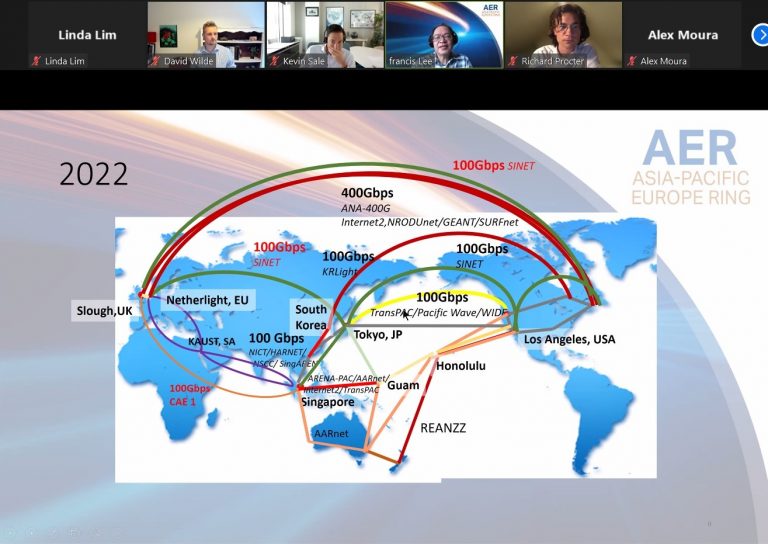4 April 2022 – SingAREN secretary, A/Prof Francis Lee, has presented at GNA-G VC Q1 2022 on the updated Asia-Pacific Europe Ring MoU on 30 March and 1 April 2022. There were 2 separate sessions to cater to participants from different geographical regions. Besides sharing the scope of this collaboration and some examples of global science, he conducted a demo on DMC21 Network Topology.
The AER system was launched in 2019 with 2x 100Gbps network linking London and Amsterdam in Europe and Singapore, Hong Kong and Tokyo in Asia. KAUST joined the AER system in 2022 and doubling the bandwidth to 400Gbps between EU and Asia.
The scope of the collaboration essentially entails supporting highly available connectivity among multiple parties with backup traffic, cooperation and engineering. An AER Engineering working group has been formed to resolve network and engineering issues related to network operation, set-up back-up routes, routing optimisation and problem resolution, support for demonstrations and support for advanced network deployments. Besides supporting network research and services such as DTN services and SDN, this collaboration also includes application development and support as well as external experiment support such as Data Move Challenge.
A/Prof Lee shared some examples of global science in terms of data type, data storage and data source. An example is the big data in ecological and environmental science from The Global Ecology and Remote Sensing Laboratory, School of Biological Sciences, University of Hong Kong. He also shared about Science Information network (SINET) which is the Japanese research and education backbone network for the use of cutting-edge research and advanced education.
Chinese University of Hong Kong (CUHK) has signed agreement with CERN to enable Physics students and scientists to take up research in Experimental Particle Physics. CUHK has setup a HPC as Tier-2 ALTAS Cluster linking with CERN HPC Cluster for physics calculation and analytics. The HPC Cluster Configuration is 18x worker node with 1008 Cores and 7x DPM disk nodes (1.06PB). The future plan is to optimise the network by LHCONE peering and to switch to ipv6.
He also presented on ITER, which is a Research TOKAMAK machine, whose objective is to solve the technical issues and address the engineering challenges currently hindering the design of a production nuclear fusion reactor. It is managed by the ITER organisation: an international collaboration involving EU, USA, JAPAN, RUSSIA, INDIA, CHINA and SOUTH KOREA. Each nuclear fusion domestic agency in those countries is entitled to get a full local copy of the whole ITER raw data. It is currently being assembled in Cadarache (South of France), with the first raw data from specific machine components expected in 2024.
A/Prof Lee then ended his presentation with the sharing of the recently completed Data Mover Challenge 2021/22 competition topology slot online, which is made possible by the global collaboration among NREN and research and education entities.


